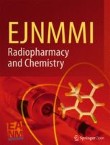Topical Collections about latest and interesting topics in EJNMMI Radiopharmacy and Chemistry are available at: https://link.springer.com/journal/41824/collections
Improved synthesis of SV2A targeting radiotracer [11C]UCB-J
[11C]UCB-J is a tracer developed for PET (positron emission tomography) that has high affinity towards synaptic vesicle glycoprotein 2A (SV2A), a protein believed to participate in the regulation of neurotransmit...

